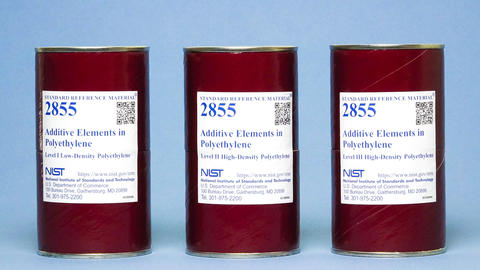Summary
Chemical metrology for polymers manufacturing is a new area of endeavor for the Chemical Sciences Division. At the outset, efforts have involved mostly elemental analysis of important virgin polymers. Elemental analysis is used by manufacturers and their customers to determine compliance with manufacturing specifications and with regulations on hazardous substances. The development of the first SRM for elements in plastic was spurred by collaboration with ASTM International Committee D20 on Plastic. Major U.S. manufacturers requested development of an SRM and assistance with test methods based on X-ray fluorescence spectrometry. The project grew to include collaboration with China's National Institute of Metrology for analyses of polypropylene.
Description

SRM 2855 Additive Elements in Polyethylene
This project is designed to strengthen the analytical capabilities of polymers manufacturers by introducing reference materials, critically evaluating standard test methods, and educating those industry representatives who participate in standards development organizations. Certified reference materials will increase the value of polymers/plastics by increasing the confidence in their performance and in their compliance with a growing number of regulations. This project is also intended to expand Chemical Sciences Division capabilities in a key industry.
Major Accomplishments
In the past several years, the following SRMs have been developed or renewed in collaboration with industry:
- Completed analysis of new SRM 2855 Additive Elements in Polyethylene
- Participated in development of one new international standard test method for elements in plastic and redevelopment of one existing standard
- Participated in CCQM Pilot Study 106 on elements in polypropylene.
Standard Methods of Test
The following industry standard method of test was developed and approved with significant contributions by NIST.
- ASTM International F2617-08 Standard Test Method for Identification and Quantification of Chromium, Bromine, Cadmium, Mercury, and Lead in Polymeric Material Using Energy Dispersive X-ray Spectrometry
The following industry standard method of test is currently undergoing improvements:
- D6247-98(2004) Standard Test Method for Analysis of Elemental Content in Polyolefins By X-Ray Fluorescence Spectrometry
Additional Technical Details
Design of materials for new SRMs is accomplished in cooperation with materials and analysis experts from industry. Specifications for composition, homogeneity, and quantity are based on current and projected industry needs. Value-assignment projects are designed to include high-performance analytical methods at NIST, state-of-the-art laboratory methods in industry, and classical chemistry methods where available and appropriate. The input of industry has been obtained through interlaboratory studies designed to provide high-quality results for SRM value assignment and to provide data representative of the performance of instrumental analysis methods in industry laboratories. This performance data can be used to improve standard test methods.

